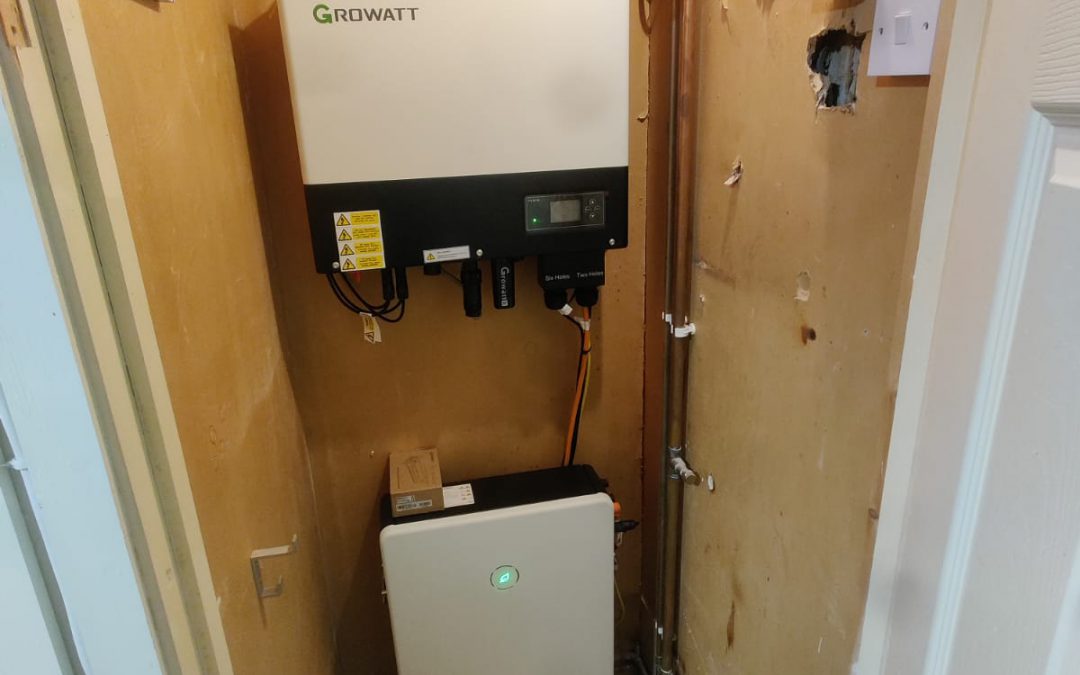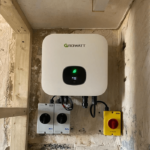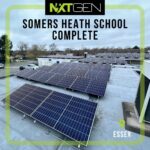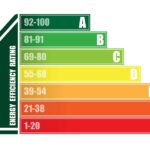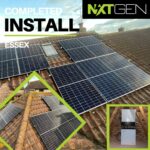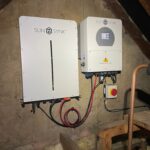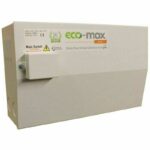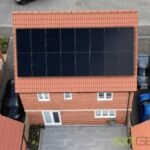What is a Solar Inverter and how does it work?
One of the key components in any solar panel system is the solar inverter. The solar inverter converts the direct current (DC) electricity that the solar panels produce into alternating current (AC) electricity that your home appliances and the National Grid use. AC electricity has a standard voltage level that varies by country, usually 120 volts or 240 volts. Without a solar inverter, you would not be able to use the solar energy from your solar panels safely and efficiently in your home or business.
The performance of your solar panel system depends on the quality of your solar inverter. A good solar inverter can optimize the amount of energy that your solar panels generate and reduce the losses due to conversion from DC to AC electricity. That’s why at NxtGen Energy we pay attention to the selection and installation of high quality solar inverters to ensure you get the best efficiency and cost savings from your solar panel system.
What does a Solar Inverter actually do?
Think of Solar inverters as the brains of a solar panel system. Their essential features include:
- They convert DC (direct current) to AC (alternating current) electricity.
- They maximise the power output of your solar panel system.
- They communicate with the National Grid for the export of power.
- They give feedback about power production of the solar panel system.
- They help ensure that your solar panel system is operating safely.
What are the different types of Solar Inverters?
In the UK there are four main types of solar inverters that you can choose from. The four types are string inverters, micro-inverters, hybrid inverters and power optimiser inverters. In this post we will explore the key characteristics of each kind of solar panel inverter. So that choosing the right solar inverter for your solar energy system couldn’t be simpler.
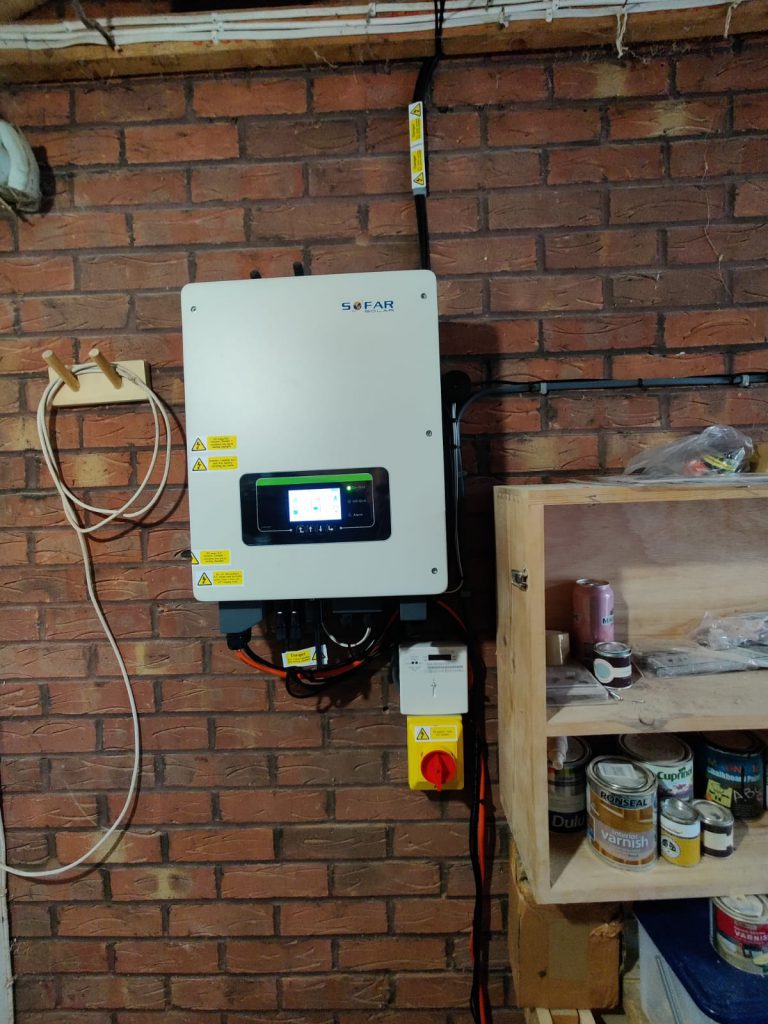
String Inverters
When you have a solar panel installation and the Solar Panels are connected in series, they form a chain called a ‘string’. A string inverter is a device that converts the DC electricity from a string of solar panels into AC electricity for your home, business or the national grid. To make sure the string inverter works well, all the panels in a string should have the same angle and direction, this is called a ‘single string’. However, you can connect more than one string to a single inverter if it has multiple MPPTs (Maximum Power Point Tracking). MPPTs are features that help the inverter find the best voltage and current for each string. This way, you can have different strings of solar panels facing different directions, such as east and west, this is called a ‘dual string’, and you still get the most out of your solar energy generation.
A single string or dual strings normally don’t connect to a battery. To add a solar battery to a string inverter you would need to add an AC charger, so if you are looking at Solar Battery Storage for your solar panel system you would be better off going for a hybrid solar inverter that has the AC charger built in.
Some of the brands that offer string inverters are Alpha, GivEnergy, Growatt, Sofar, SolarEdge, Solax and Solis.
Pros and Cons of String Inverters
Pros
- A reliable and trusted form of solar technology, which allows for multiple strings of panels.
Cons
- Limited design flexibility which may not suit more complicated solar energy projects.
- If one panel is damaged or shaded the performance of the entire solar system is affected.
- You will have to add an AC charger if you want to use solar battery storage.
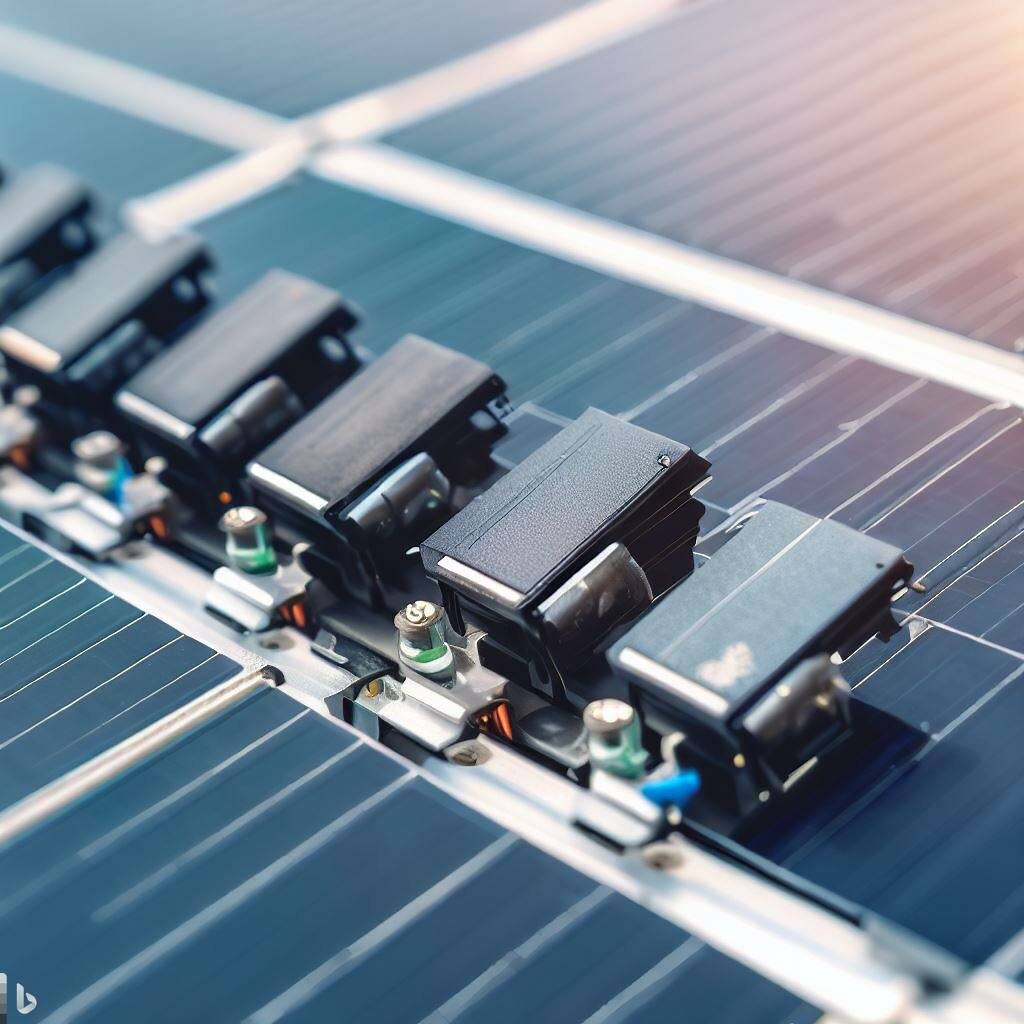
Micro Inverters
Micro inverters are a new and innovative technology that offer many benefits for home solar panel systems. Unlike string inverters, which can reduce the performance of the whole system if one solar panel is faulty or shaded, micro inverters work independently for each solar panel. This means that any problem with one panel will not affect the others. Micro inverters also allow you to install more panels on your roof, even in areas that are partially shaded or have different orientations. Although micro inverters are usually more expensive than string inverters, they can increase your solar energy generation and payback over time.
Pros and Cons of Micro Inverters
Pros
- Micro inverters allow for individual solar panel monitoring, which is great for finding faults in specific panels and monitoring performance levels of your entire solar panel system.
- Enphase micro inverters have a feature called ‘Burst Mode” which converts low power levels in solar panels with higher conversion efficiencies, which is a great bonus.
Cons
- The main downside of micro inverters is that they have a higher initial cost, compared to a string inverter.
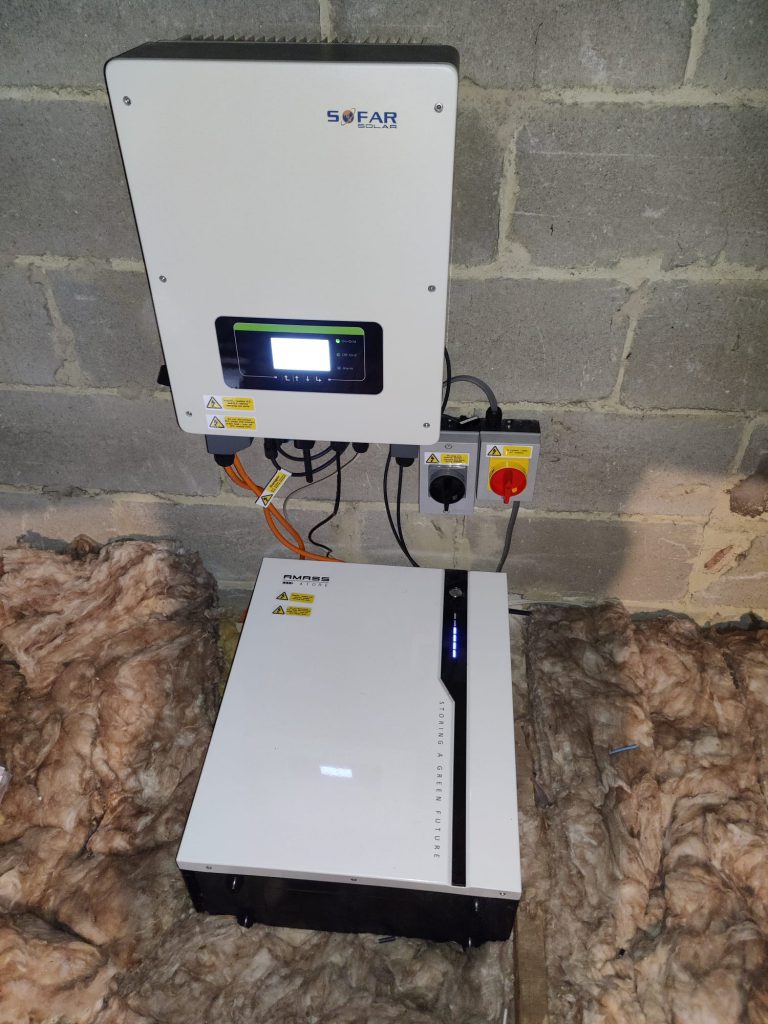
Hybrid Solar Inverters
A hybrid solar inverter is a device that can help you make the most of your solar panel system with storage. It converts the DC (direct current) electricity from your solar panels into AC (alternating current) electricity that you can use in your home or business. It also manages the flow of DC electricity to and from your solar battery and the national grid. When your solar panels produce more electricity than you need, the hybrid inverter can store the excess electricity in your solar battery or sell it to the national grid. When your solar panels produce less electricity than you need, the hybrid inverter can draw power from your battery or the national grid. This way, you can optimize your energy consumption and your cost savings.
Some of the brands that offer hybrid solar inverters are Growatt, GivEnergy, Solis, Sofar, SolarEdge, Solax and Alpha.
Pros and Cons of Hybrid Solar Inverters
Pros
- Hybrid inverters can be integrated directly into your solar battery storage, and therefore centralise the monitoring of the solar panel array performance.
Cons
- If you already have a solar panel system installed and you are looking to add solar battery storage to your system, then financially it is better to install an AC charger over a new inverter.
- Hybrid inverters are about 50% more expensive than string inverters. They also only integrate with DC solar batteries, this can sometimes limit your solar battery storage choice.
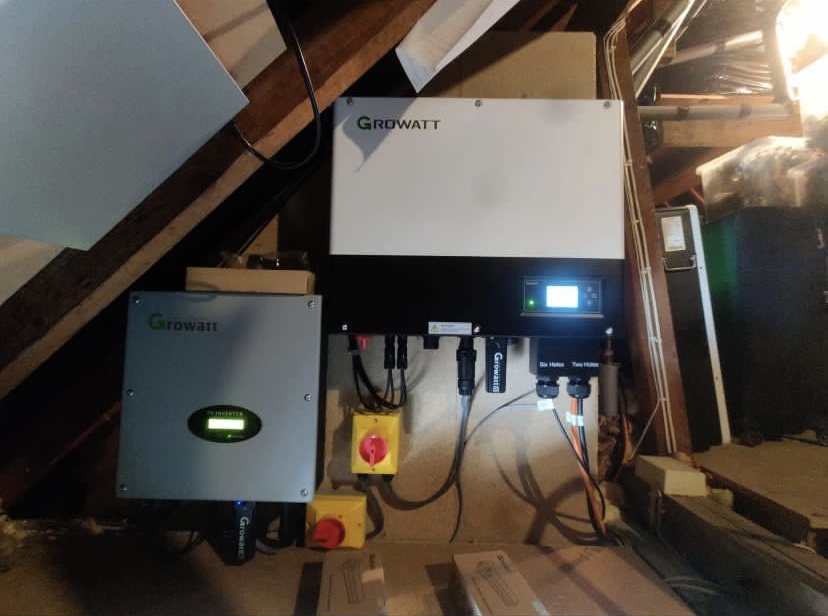
Power Optimiser Inverters
Power optimiser inverters are devices that can improve the efficiency and monitoring of your solar panels. They are also called DC power optimisers, because they optimize the DC electricity output of each panel. They are similar to micro-inverters, but they do not convert the DC electricity into AC electricity on the roof. Instead, they send the DC electricity to a string inverter, which is usually located near your battery storage system. Power inverters are often cheaper than micro-inverters, but they still offer the advantages of panel-level optimisation and performance monitoring.
One of the best brands for power inverters is SolarEdge. Their products can increase your solar energy generation, detect any issues and prevent any electrical faults. By choosing a SolarEdge PV System, you are choosing to generate more clean energy.
Pros and Cons of Power Inverters
Pros
- Power inverters are a cheaper alternative to Micro-inverters.
- Power inverters allow for maximum energy production, reducing the impact of shading and even mismatched modules.
- A SolarEdge power Inverter offers a record-breaking 99% efficiency,
Cons
- They are 50% more expensive than string inverters.
So, which Solar Inverter is right for your solar energy project?
Every residential home and business property requires different solar needs. It’s important to choose the right solar inverter for your solar energy project. Hence why our team here at NXTGEN Energy offer a free quote and free consultations to design you with a bespoke solar panel system. Looking for solar panel installers in London, Essex, Hampshire, Kent, Suffolk or Norfolk? We are MCS Certified Solar Panel Installers, when you choose NXTGEN Energy for your solar energy project you know you are in safe hands. Call us today on 01268 928 690 or click the ‘Enquire Now’ button to talk to a solar expert.
Frequently Asked Questions About Solar Inverters
What are the 4 types of inverters? In the UK there are four main types of solar inverters that you can choose from. The four types are string inverters, micro-inverters, hybrid inverters and power optimiser inverters.
String inverters are the standard for most residential home systems. They work by connecting multiple solar panels into an array (single string on one part of your roof or dual string on multiple parts of your roof) and sending the power to a centralized solar inverter for DC (direct current) to AC (alternating current) conversion that’s compatible with the national grid. String inverters are affordable and efficient.
How do I know what size solar inverter to buy? Your inverter should be aligned with the DC rating of the solar panel system itself. So, if you have a 6 kilowatt (kW) system you will need a solar inverter that is around the 6000 W mark to match it.
Can I use solar panels and solar inverters without solar battery storage? The answer is yes, if you are connected to the national grid, you can use solar panels and solar inverters without solar battery storage.
When do you need to replace a solar inverter? While most solar power inverters come with a lifespan of approximately 5 to 10 years, they do require regular maintenance in order to ensure optimal solar inverter efficiency.
Do you have to maintain your solar inverter? A solar inverter requires very little maintenance. Once you make sure it’s properly installed, you simply need to keep it clean. Wipe it free of any accumulating dust, debris, and cobwebs on a regular basis.
Latest Solar Panel Posts
- Solar Inverter Placement in Your HomeSolar Inverters Solar inverters are crucial for converting the direct current (DC) electricity generated by your solar panels into alternating current (AC) electricity for use in your home. The placement of your solar inverter can impact the efficiency and overall performance of your solar energy system. Things to consider when choosing where to place your… Read more: Solar Inverter Placement in Your Home
- School Funding – Solar for SchoolsSolar energy is revolutionizing the way educational institutions approach sustainability and energy consumption. As schools seek innovative solutions to reduce costs, educate students about renewable energy, and minimize their environmental impact, the adoption of solar power has emerged as a compelling choice. Solar For Schools, a leading initiative in the field, empowers educational institutions to… Read more: School Funding – Solar for Schools
- Homes with solar panels can sell for more than those withoutHarnessing the power of the sun to generate clean, renewable energy is not only a sustainable choice for homeowners but also a lucrative investment in the UK property market. Homes equipped with solar panels are increasingly commanding higher prices and attracting more buyers than their non-solar counterparts. In this blog post, we’ll delve into the… Read more: Homes with solar panels can sell for more than those without
- NXTGEN Energy has been shortlisted in the 2024 Clean Energy AwardsWe have been officially recognised for our ‘Exceptional Customer Satisfaction‘ and ‘Energy Efficiency Initiative of the Year‘ in this year’s awards. Congratulations to the entire team at NXTGEN Energy Limited, including our Great Bosses Sam Barr MCIOB and Chris Day, our Sales Director Bobby Barnes, our amazing Energy Office Manager Kelly, the very talented Social… Read more: NXTGEN Energy has been shortlisted in the 2024 Clean Energy Awards
- Solar Panels and EPC RatingsSolar panels have become increasingly popular as a sustainable energy solution, offering numerous benefits for both residential and commercial properties. In parallel, Energy Performance Certificate (EPC) ratings serve as indicators of a building’s energy efficiency. Understanding how solar panels can impact EPC ratings is crucial for maximizing energy savings and environmental benefits. This blog post… Read more: Solar Panels and EPC Ratings
- Is it worth buying solar panels in Basildon, Essex?☀️ Over 10,000 homes in Basildon have a solar panel system installed. ☀️ You’ll normally break even on solar panels in less than 10 years. ☀️ A 3.5kW solar panel system will cost about £7,000 on average. Solar panels are becoming more affordable and more common in the UK, with over 1.3 million households already… Read more: Is it worth buying solar panels in Basildon, Essex?
- SunSynk Batteries: Innovative Energy StorageSunSynk Batteries have emerged as a leading solution in the realm of energy storage, offering a range of innovative features and benefits that cater to various applications. With a focus on sustainability and cutting-edge technology, SunSynk Batteries have captured the attention of residential, commercial, and industrial consumers alike. This blog post delves into the intricate… Read more: SunSynk Batteries: Innovative Energy Storage
- Solar Industry Update: Battery Installations in LoftsThe British Standards Institute (BSI) has recently released new recommendations regarding home battery installations, including those in loft spaces. One common inquiry we receive from our customers following the publication of the Publicly Available Specification (PAS) is whether a solar battery can be installed in a loft. The answer is a resounding yes, with some… Read more: Solar Industry Update: Battery Installations in Lofts
- Voltage Optimisers, What Are They and How Do They Work?What is voltage optimisation? A voltage optimiser is a smart device that can help you save energy and reduce your carbon footprint. It works by adjusting the power supply from the National Grid to the ideal level for your electrical devices and appliances at home or work. This way, you can use less electricity and… Read more: Voltage Optimisers, What Are They and How Do They Work?
- Wiltshire’s Good Energy Partners with bigHead to Achieve 50% Solar Energy GoalWiltshire-based Good Energy has played a crucial role in helping Dorset manufacturing firm bigHead transition to utilizing solar power for 50% of its energy needs. Thanks to the collaboration between the two companies, bigHead has successfully installed 130 solar panels on the roof of its Verwood factory, resulting in significant cost savings of over £4,000… Read more: Wiltshire’s Good Energy Partners with bigHead to Achieve 50% Solar Energy Goal
- NXTGEN Energy Reviews March 2024A roundup of a few of our recent 5-Star Trustpilot Reviews and Google Reviews for NXTGEN Energy Reviews for March 2024. Martin Pattinson We initially used NxtGen for our consultation and this went really well. NxtGen then subcontracted to Cozy Energy, which again was fine. The installation went well. It was then that things started… Read more: NXTGEN Energy Reviews March 2024
- Unveiling the Perfect Fit: How Many Solar Panels Can Your Roof Handle?Harnessing the power of the sun is an attractive proposition for many UK homeowners. But before diving headfirst into solar energy, a crucial question arises: how many solar panels can fit on your roof? The answer, unfortunately, isn’t a simple one. It’s a captivating interplay between several factors, each one requiring careful consideration. Understanding Your… Read more: Unveiling the Perfect Fit: How Many Solar Panels Can Your Roof Handle?

